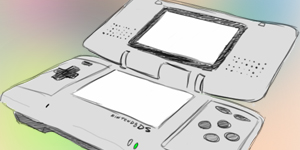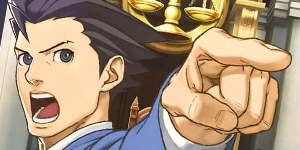Extra: NFC’s Future is e-Reader’s Past
Nintendo is a very persistent company. If a concept fails, they try it over and over until it works. Take GameCube/Game Boy Advance connectivity: when the system link-up didn’t catch on due to the extra expense of requiring both systems, Nintendo simply took the handheld screen and stuck it right in the console controller, giving us the Wii U. Or take 3D gaming: after Virtual Boy flopped and prototype 3D panels for the GameCube proved unrealistic, Nintendo tried a third time and gave us the 3DS. Now, Nintendo is taking another concept from the past and making it work: the combination of real-life objects with virtual worlds. The company is currently implementing the idea using an NFC (near field communication) reader in the Wii U’s GamePad. But eleven years ago, Nintendo took its first stab at such a concept with a Game Boy Advance add-on called the e-Reader. As history shows, what Nintendo did in the past with the e-Reader gives a good indication of what they will do in the future with NFC.
Much like how Skylanders uses physical toys to import characters into games, the e-Reader let players enhance Game Boy Advance and even GameCube games through cards. By swiping a variety of cards through the e-Reader’s dot code scanner, players were able to import objects into games, access additional data, play minigames, and even launch entire games. Nintendo had high hopes for the accessory when it launched in North America in September 2002. The company released a variety of card packs that featured big properties like Mario, Animal Crossing, and classic NES titles. They also tied in the e-Reader with the Pokemon Trading Card Game by placing dot codes on new Pokemon cards. With a quick swipe of a card, fans could access the Pokedex entry for that Pokemon and in some cases, bonus minigames or animations. The entire concept was also backed by a large marketing campaign that featured claymated commercials and free card giveaways at Toys R Us and E3, in magazines such as Nintendo Power and Tips & Tricks, and even bundled with games such as Pokemon Channel for the GameCube.

The versatility of the technology was equally impressive. Classic NES games were each sold as a five-card set, letting GBA owners access full ports of each game’s single-player mode just by swiping. For Super Mario Advance 4: Super Mario Bros. 3, Nintendo released two separate 18-card series that let players unlock exclusive new levels and additional items. A similar move was made for Pokemon Ruby and Sapphire, in which players could collect and swipe Pokemon Battle-e cards to encounter additional trainers, earn extra berries, or visit Southern Island to catch Latias or Latios via a physical EON Ticket card. The e-Reader also utilized GameCube/Game Boy Advance connectivity, which resulted in support for both Animal Crossing and Pokemon Channel. By scanning Animal Crossing-e cards, which were available in randomized packs and through promotional giveaways, players could unlock new items, designs, and town tunes. Pokemon Channel didn’t get its own series of cards, but instead came bundled with three cards that included extra patterns for the game’s art mode and two ‘pages’ for the in-game coloring book.
Utilizing the e-Reader, Nintendo also flipped the concept of bringing the real world into video games with Mario Party-e. For this, the video game was brought into the real world with an actual card game based on Mario Party. Sold as a 64-card deck, Mario Party-e contained eleven minigames for Game Boy Advance. As players came across the minigame cards through the normal course of the game, they then swiped them into the e-Reader to play.

As great as the e-Reader sounds in concept, there were a number of issues that led to a relatively quick demise in the US. First, there was the swiping itself. While simple activities like importing an item into Animal Crossing or checking Pokedex data only required a single card, many of the e-Reader’s cooler features required players to sit and swipe multiple times. Want to play Donkey Kong 3 or any other NES game? That required swiping five cards with two dot codes each – a total of ten swipes. The swiping was even more off-putting due to the unreliability of the e-Reader’s dot code reader, which required an exact swiping speed to properly read each card’s dot code. More often than not, one would be greeted by an error message instead of a game.
One other issue was how the e-Reader integrated with the Game Boy Advance SP. On the original GBA, the link cable port and cartridge slot were right next to each other. This allowed for the e-Reader to easily plug into both and support GameCube connectivity. On the GBA SP, however, the port and slot were no longer next to each other. This meant that while the e-Reader could plug into the cartridge slot and be used on the GBA SP without any issue, it did not support any of the GameCube capabilities via link cable and the physical link cable plug stuck out above the SP’s casing (see picture below). Considering the GBA SP was released a mere seven months after the e-Reader, this was an odd yet significant oversight.

For the above reasons and presumably a mere general lack of interest, the e-Reader never caught on in North America. The card sets released offered a nice variety of uses for people who did purchase an e-Reader (such as myself), but Nintendo of America abandoned the add-on fairly quickly. Japan, on the other hand, saw additional card sets for Mario Advance 4, Pokemon Emerald, Pokemon FireRed and LeafGreen, F-Zero: GP Legend, Pokemon Pinball: Ruby & Sapphire, Pokemon Colosseum, and even two different Mega Man titles. None of these cards crossed the Pacific and all references to the cards – and the features they unlocked – were scrubbed from the American versions of the games.
The e-Reader had its flaws, but for every issue it faced, there’s a solution found in NFC. Unreliable swiping is replaced by simply placing an object on a surface. This even alleviates Nintendo’s attempts at using the 3DS’s augmented reality capabilities as an e-Reader 2.0, if you will. Yes, the 3DS comes bundled with AR cards and yes, Kid Icarus: Uprising has over 400+ AR cards for unlocking additional goodies. However, you still need to hold the 3DS just right, make sure the lighting is perfect, and stay steady. NFC doesn’t require that. Additionally, unlike the e-Reader, which did not work exactly the same for every Game Boy owner due to the GBA SP’s design changes, the Wii U’s GamePad feature is universal. All Wii U owners can use it, plus it has the distinct advantage of being a system feature and not an aftermarket add-on. This ensures a larger userbase right from the start. Another guarantee of a large userbase is NFC’s success thus far. The $1 billion sales of the Skylanders games/toys and Disney’s deep commitment to its upcoming Disney Infinity game/toy line demonstrate a very strong consumer interest in combining real-life collectables with video games.

Nintendo is clearly aware of all of this as they are already dabbling in the toy-to-game concept with Pokemon Rumble U, which will let players import seven different character figurines into the downloadable title. This feels more like Nintendo is testing the NFC waters than jumping in full force, but there’s no doubt that once Nintendo does commit, it can use its e-Reader experience to offer a slew of creative NFC uses. Imagine if Nintendo once again tapped into the Pokemon Trading Card Game, allowing players to import physical cards into a new virtual version with a simple tap on the GamePad’s NFC reader. Nintendo could bring back the e-Reader’s concept of NES collections, replacing cards with 8-bit figurines or viynl cartridge collectables that include NFC-based unlocks for Virtual Console downloads. Maybe they could release Animal Crossing toys and accessories, each of which unlocks a digital counterpart in the franchise’s eventual Wii U entry. Perhaps Nintendo can even bring back Mario Party-e, creating a real-world variation of the party game that requires players to play an actual board game in tandem with the Wii U. Whatever Nintendo ends up doing, it’ll certainly be an exciting time for Wii U owners. And a sad time for their wallets.



